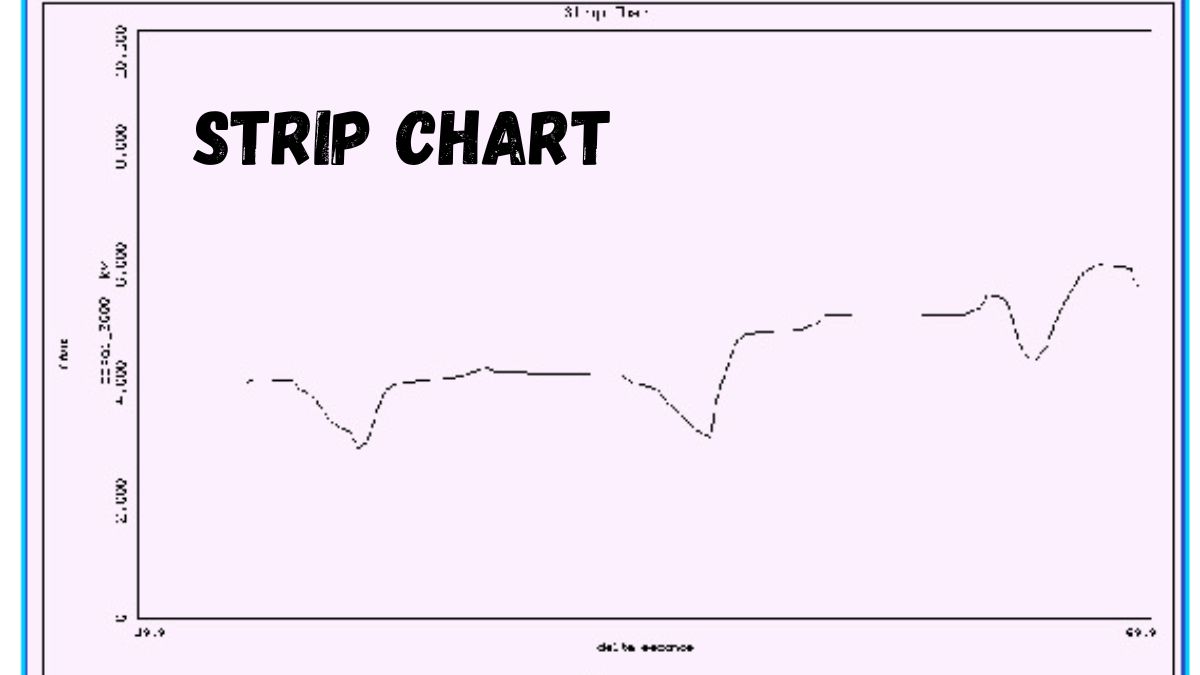TOPIC
Strip Chart vs. Line Graph: When to Use Each Visualization Tool

Data visualization is a powerful tool that transforms complex information into clear, understandable visuals. It allows us to grasp insights quickly and makes data-driven decisions easier. Among the many options available for visual representation, strip charts and line graphs stand out as popular choices. Each of these tools offers unique advantages depending on the nature of your data and what you aim to convey.
Have you ever found yourself grappling with which visualization to use? You’re not alone! Understanding when to employ a strip chart versus a line graph can significantly enhance how your audience interprets your data. Let’s dive into each option and discover their strengths, weaknesses, and best applications in various scenarios. Whether you’re presenting research findings or tracking trends over time, choosing the right visualization tool can make all the difference in communicating your message effectively.
Understanding Strip Chart and Line Graphs
Strip charts and line graphs are powerful tools for visualizing data, each serving unique purposes. A strip chart displays individual data points along a single axis, allowing viewers to see the distribution of values in a clear manner. This format excels at revealing clusters and outliers.
On the other hand, line graphs connect data points with lines, emphasizing trends over time or continuous variables. They help highlight patterns that may not be immediately visible in other formats.
Both visualizations provide insights but cater to different needs. While a strip chart often reveals variability within groups, a line graph is ideal for tracking changes and movements across intervals. Understanding these distinctions can significantly enhance your ability to communicate complex information effectively.
Similarities and Differences between Strip Chart and Line Graphs
Strip charts and line graphs are both popular tools for visualizing data, but they serve different purposes.
Both can display trends over time or among categories. They allow viewers to quickly grasp complex information at a glance. This makes them useful in various fields, from science to business.
However, the way they present data differs significantly. Strip charts show individual data points along a single axis, highlighting distribution and variability within groups. You can easily see clusters or outliers that might otherwise be missed.
In contrast, line graphs connect those points with lines to illustrate continuous trends over time. They provide a clear trajectory of change rather than focusing on individual values.
Choosing between these two depends on what you need to convey: precise distributions with a strip chart or smooth transitions using a line graph. Each has its unique strengths tailored for specific analytical needs.
When to Use a Strip Chart
A strip chart is ideal when you want to display individual data points while showing their distribution. This visualization method excels in highlighting variance and outliers within a dataset.
Consider using a strip chart for categorical data, especially with smaller sample sizes. It allows viewers to see how values are spread across different categories without losing the essence of each point.
If your goal is to emphasize patterns or behaviors over time but maintain focus on specific observations, a strip chart can be more effective than other visualizations.
They are particularly useful in fields like biology or social sciences, where understanding variability matters. When presenting experimental results or survey responses, the clarity afforded by a strip chart helps convey complex information effectively without overwhelming the audience.
When to Use a Line Graph
Line graphs are ideal for displaying data trends over time. If you’re charting changes across days, months, or years, a line graph is your best friend.
This visualization excels in showing relationships between variables. When one variable depends on another, the smooth lines make it easy to see how they interact.
For example, if you’re tracking sales growth alongside marketing expenditures, a line graph can highlight correlations clearly. It allows viewers to grasp increases and decreases at a glance.
If you’re presenting continuous data sets where precision matters, consider using a line graph. The clarity of plotted points connected by lines conveys nuanced shifts without overwhelming the audience.
When comparing multiple datasets simultaneously—like different product performances—a multi-line graph tells an engaging story of competition and performance metrics that audiences find compelling.
Best Practices for Using Strip Chart and Line Graphs
When using strip charts, consider the data distribution. They excel in displaying individual data points and can reveal clusters or outliers effectively. Always ensure you have enough room on the y-axis to showcase meaningful variation.
For line graphs, focus on time series data. A clear timeline is essential for tracking trends over intervals. Use distinct colors or styles for multiple lines to avoid confusion among viewers.
Label your axes clearly in both visualizations. This enhances comprehension significantly. Keep legends concise but informative.
Maintain simplicity in design by avoiding unnecessary embellishments that distract from the data narrative. Well-chosen colors enhance readability while also making key insights pop.
Test your visuals with a sample audience if possible. Feedback can help refine your approach and ensure clarity before sharing broader messages through these powerful tools.
Conclusion: Choosing the Right Visualization Tool for Your Data
Selecting the right visualization tool is crucial for effectively conveying your data’s story. Strip charts and line graphs serve distinct purposes, each suited for different types of data analysis.
If you want to highlight variations in individual data points or emphasize distributions, a strip chart might be your best choice. It allows viewers to see detailed information at a glance and can be particularly useful when working with smaller datasets.
On the other hand, if you’re looking to display trends over time or illustrate how values change sequentially, then a line graph is more appropriate. This type of chart provides clarity on overall patterns and makes it easy to compare multiple series across the same timeline.
Understanding your audience’s needs and the nature of your data will guide you toward choosing between these two powerful visualization tools. Whether it’s showcasing precise measurements with a strip chart or outlining broader trends with a line graph, making an informed decision will enhance both comprehension and engagement with your content.
TOPIC
Enhance Your Sleep: The Benefits of a Mattress Topper Queen

A tranquil night’s sleep is instrumental for our wellbeing and day-to-day functioning. With the extensive array of bedding accessories available in the market designed to elevate sleep quality, selecting the right one is paramount for individual comfort needs. Among these, a mattress topper queen size has gained popularity for its ability to transcend your sleeping experience to new heights of comfort.
What is a Mattress Topper?
A mattress topper is a removable layer that sits on top of a mattress to provide additional support and cushioning. It’s crafted to enhance the feel of your mattress and can be particularly beneficial if your existing mattress is too firm or if you’re seeking an extra layer of comfort without the expense of purchasing a new mattress.
Offering a Customised Comfort Level
One primary advantage of a mattress topper queen size is that it allows you to tailor the firmness of your bed to your liking. Whether you prefer a softer surface that cradles your body, or something that provides firm support to your back, a topper can make all the difference. They come in various materials such as memory foam, latex, down, and wool, each lending a unique comfort profile.
The Convenience Factor
Queen size mattress toppers are particularly convenient as they are easy to install and can be as simple as laying it over your existing mattress, securing it with your fitted sheet. The simplicity of use and the ability to remove and clean them also make mattress toppers an attractive option for maintaining a hygienic sleep environment.
Enhanced Support and Reduced Pressure Points
Alleviating pressure points while you sleep is vital for preventing discomfort and pain. A mattress topper queen can contour to your body, distribute your weight evenly and reduce the stress on pressure points such as hips, shoulders, and knees. This not only aids in a more restful sleep but also minimizes the tossing and turning that often disrupts it.
Extending Mattress Lifespan
If you’re hesitant to invest in a new mattress, a topper can be an excellent way to extend the life of your current one. By absorbing much of the wear and tear, a topper can save the mattress beneath from the brunt of daily use, potentially delaying the need for a costly replacement.
Temperature Regulation
Many modern mattress toppers are designed with temperature regulation in mind. Memory foam, gel-infused toppers, for example, can wick away heat and help keep you cool during the night. A well-chosen topper can be a game-changer for those who tend to sleep hot.
Cost-Effective Comfort Upgrade
With the price of high-quality mattresses being considerable, a mattress topper offers a more affordable way to revitalise your sleep experience. It’s a cost-effective solution that provides similar benefits to a new mattress at a fraction of the cost, particularly beneficial for those on a budget.
Portability and Versatility
A mattress topper queen can easily be rolled up and stored or transported, making it a versatile choice for those who need an additional comfort layer on the go. It’s perfect for guest rooms, travel, or as temporary bedding during a move.
Improved Sleep Quality and Health Benefits
Improved sleep quality can lead to various health benefits, such as enhanced mood, better cognitive function, and a healthier immune system. A comfortable mattress topper can contribute to a deeper state of rest and thereby, overall health improvements.
Choosing the Right Mattress Topper
When selecting a mattress topper, consider the material that aligns best with your comfort preferences, any allergies, and the level of support you need. Pay attention to the thickness and density, as these will impact the comfort and support the topper provides. Additionally, look for quality certifications that indicate the product is free from harmful chemicals.
The Importance of Proper Care
To maximise its lifespan, it’s essential to care for your mattress topper correctly. Follow the manufacturer’s instructions for cleaning and maintaining it, and use mattress protectors to shield it from spills and stains.
Conclusion
A mattress topper queen size is a valuable addition to any sleep setup, offering a multitude of benefits such as customised comfort, enhanced support, and longevity for your mattress. For those looking to improve their sleep without the significant investment of a new mattress, a mattress topper is an ideal solution.
Consider the myriad of advantages, from mitigating pressure points to cost-effective comfort upgrades, a mattress topper can be a transformative sleep accessory. As many have discovered, the addition of a mattress topper queen to their bedding ensemble is the key to unlocking unparalleled slumber night after night.
TOPIC
Effective Pest Control Strategies for Nowra, NSW Residents

Pest infestation is a significant concern for many homeowners in Nowra, NSW. Not only does it pose health risks, but it can also lead to property damage and spoil the peaceful ambience of any household. Understanding the right strategies for pest control in Nowra NSW is essential for maintaining a safe and comfortable living environment. This article will delve into the various effective pest management techniques tailored for residents of Nowra, with a focus on both prevention and eradication.
Understanding the Local Pest Landscape
The first step in effective pest management is recognising the common pests that inhabit Nowra. Each pest species requires a distinct approach for control and prevention. The region’s climate and natural conditions contribute to the prevalence of a variety of pests, from insects to rodents. Thorough knowledge of these pests, their life cycles, and their habits is fundamental for tailoring the correct control strategy.
Regular Home Inspection
Routine home inspections are critical in the early detection of pest activities. These inspections should encompass both the interior and exterior of homes, paying close attention to hidden crevices, dark corners, moisture-prone areas, and entry points. Homeowners should practise vigilance, spotting signs such as droppings, structural damage, or nests, which typically indicate a brewing infestation.
Sanitation and Maintenance
Sanitation cannot be overstated when it comes to pest control. Pests often invade homes searching for food, water, and shelter. Ensuring that all food is stored away in sealed containers, surfaces are regularly cleaned to remove crumbs and spills, and garbage is properly disposed of can considerably reduce the attraction of pests. Additionally, regular maintenance tasks like fixing leaks, sealing gaps, and repairing damage are essential to eliminate possible pest entry points.
Natural and Chemical Repellents
Both natural and chemical repellents can be effective in deterring pests. For those seeking eco-friendly options, natural repellents such as essential oils, diatomaceous earth, or plants like lavender can be utilized as deterrents. In contrast, chemical repellents and baits can provide a stronger, more immediate impact. However, their use should be carefully managed to avoid potential health risks to humans and pets.
Utilizing Traps
Trapping is an age-old method of pest control that remains effective today. Various types of traps are available, depending on the target pest—ranging from sticky traps for insects to baited cages for rodents. Strategic placement and regular monitoring of these traps can significantly reduce pest populations.
Professional Pest Management Services
While DIY methods are invaluable, certain pest infestations require professional expertise. Engaging a reputable provider of pest control services can guarantee a comprehensive assessment of the issue and the implementation of effective, long-term solutions. Professionals are equipped with advanced tools and knowledge of industry-grade pesticides that can safely and efficiently resolve pest problems.
Integrated Pest Management (IPM)
Integrated Pest Management (IPM) is a holistic approach that incorporates several strategies for sustainable pest control. The aim of IPM is to reduce pest populations to acceptable levels using environmentally sensitive methods, which might include a combination of biological controls, habitat manipulation, and the prudent use of pesticides when necessary.
Educating the Community
Involving the local community in pest management can enhance the effectiveness of control measures. Educational initiatives that inform residents about pest prevention methods, as well as the importance of a coordinated approach, help foster a collaborative environment where shared challenges can be tackled more competently.
Monitoring and Evaluation
Consistent monitoring and evaluation of pest control strategies are essential to determine their efficacy. It allows residents to adapt and refine their approach. Tracking pest sightings, recording the success rate of different control methods and remaining adaptable to the changing environment ensures that pest control measures remain effective throughout the year.
Landscape and Garden Care
Outdoor areas contribute significantly to pest management. The careful selection of plants, regular weeding, and proper disposal of garden waste reduce habitats for pests. Additionally, ensuring that landscaping does not provide easy access to the home is pivotal in preventing pest infestations from taking hold.
Seasonal Pest Control Measures
Pests often have seasonal patterns, where certain times of the year are more conducive to their activity. Recognising these patterns allows residents to implement targeted preventative measures. For example, before the onset of warmer weather, which can bring about increased insect activity, residents might focus on sealing their homes and clearing potential nesting sites.
Collaboration with Local Authorities
Local authorities in Nowra often have pest control programmes in place that residents can participate in or learn from. Keeping abreast with municipal pest management plans allows homeowners to complement their efforts with the broader strategies employed by the community, harnessing synergies for improved overall results.
Incorporating Technology in Pest Management
The use of technology has become increasingly prevalent in pest management. Automated pest monitoring systems, smart traps, and data analytics can provide sophisticated approaches to controlling pest populations. Residents embracing these technological advancements can benefit from greater precision and efficiency in their pest control endeavours.
Final Thoughts on Pest Control in Nowra, NSW
Effective pest control requires a multifaceted approach, integrating preventative maintenance, proper sanitation, and targeted eradication measures. For residents of Nowra, NSW, understanding the local pest landscape and leveraging the support of professional pest control in Nowra NSW services, when needed, is crucial. By combining these strategies with community education and technological tools, homeowners can sustain a pest-free environment and protect their homes and health.
Pest Control: A Collaborative Effort for Community Well-being
Ultimately, pest management is not just an individual concern but one that affects the well-being of the entire Nowra community. By employing these strategies and working together, the residents can enjoy their homes and lives without the undue stress brought about by unwanted pests. With the right knowledge and resources, effective and sustainable pest control is within reach.
TOPIC
Juice Head Vape Juice Flavors: Which Ones Are the Best?

The Juice Head brand has really taken the vaping industry by storm over the last few years. They did that by hitting every segment of the market at once with a wide assortment of both bottled e-liquids and disposable vapes. That way, people could experience Juice Head’s flavor selection regardless of whether they preferred refillable vapes or disposables. Releasing products in both categories at the same time helped to make Juice Head one of the world’s leading vape brands, and that’s exactly what they remain today.
At the end of the day, the success or failure of any vape brand depends on the quality of its flavors – and that’s where Juice Head shines. The brand’s flavor selection has made Juice Head vape juice the talk of the vaping community, and we’re going to introduce the full range of Juice Head flavors to you in this guide.
Not sure which option to try first? Here’s a complete roundup of every Juice Head flavor that you can buy today.
Fruit Flavors
Fruit flavors form the main part of Juice Head’s flavor lineup. They’re so core to the brand’s identity, in fact, that they represent almost everything Juice Head offers. You won’t find any plain tobacco or menthol e-liquids here – even most of the brand’s dessert flavors have fruity elements.
One of the fun things about Juice Head’s fruit flavors is that they’re all available with or without menthol. If you prefer a fruity e-liquid with added ice, just look for the version of that flavor with “Freeze” in the name. If you don’t see the word “Freeze,” it’s the standard version of the flavor.
- Apple Watermelon: All aboard for a trip to your favorite summer orchard! Two of your favorite seasonal flavors – crisp red apple and juicy watermelon – coexist here in perfect bliss, giving you a delightful dose of refreshment with just a bit of complexity to keep you interested.
- Blueberry Lemon: Every once in a while, an e-liquid company releases a flavor that transcends the brand and becomes one of the most popular flavors in all of vaping. That’s exactly what has happened with Blueberry Lemon, which is easily the most popular Juice Head flavor that you can buy. If you haven’t tried anything from this brand yet, Blueberry Lemon is definitely the one that you should grab first.
- Guava Peach: Guava Peach is a bit of an east-meets-west flavor, which is a theme that you’ll see often across the Juice Head product line. Guava has a taste that’s rich and slightly musky, and it pairs really well with this flavor’s crisp peach note.
- Mango Strawberry: Mango and strawberry are probably the most popular of all fruity notes in vaping, so why not combine the two? The sweetness of Juice Head’s mango base is perfectly offset by the addition of the slightly tart strawberry.
- Orange Mango: A great mango vape is even better when it’s combined with a flavor that provides a little tang, and that’s exactly what you’ll get here. The orange note brightens the overall flavor profile, creating an experience that’s absolutely irresistible.
- Peach Pear: What’s your favorite juicy summer tree fruit – peach or pear? With Juice Head’s Peach Pear flavor, you won’t have to decide because you can enjoy both of them at the same time.
- Pineapple Grapefruit: Here’s a tropical offering from Juice Head with an extra touch of tartness for anyone who appreciates a vape juice with a sour side. Pineapple and grapefruit are both fairly tangy, but there’s no need to feel overwhelmed because Pineapple Grapefruit has plenty of sweetness on offer as well.
- Pineapple Guava: Pineapple Guava is a flavor from Juice Head that has a good amount of complexity thanks to the nice balance of tangy pineapple and sweet, rich guava. If you appreciate a vape flavor with a tropical vibe, you’ll definitely be a fan of this one.
- Pineapple Orange Guava: This flavor riffs on the classic Hawaiian POG beverage by replacing the traditional passionfruit with pineapple for an experience that’s fresh and different but still unmistakably tropical.
- Strawberry Kiwi: Everyone’s favorite bottled juice in vapor form. You know that you always grab the kiwi-strawberry juice when you walk by the refrigerators at the market; here’s an opportunity to enjoy the same experience without the massive quantity of sugar.
- Watermelon Lime: Most of Juice Head’s fruity flavors provide just a little bit of tartness, but this one is skewed a bit more in that direction. It’s an incredibly refreshing experience.
- Watermelon Strawberry: Why force yourself to choose between watermelon and strawberry when you can enjoy them both at the same time?
Dessert Flavors
While a great fruity e-liquid often has a blend of sweet and sour elements, it’s more common for dessert e-liquids to tend toward the sweeter side of the flavor spectrum. Although Juice Head focuses on fruity flavors with the majority of their flavors, they do have several delicious dessert options for people who prefer a more decadent vaping experience.
- Cake Batter: One of the only Juice Head flavors that doesn’t include a fruity note, Cake Batter proves that this company’s brilliant mixologists can succeed at absolutely anything.
- Fruity Cream: During the height of summer, there’s no better way to enjoy the bounty of the season than by enjoying a simple dessert of fresh fruit with a bit of whipped cream spooned on top. Juice Head’s Fruity Cream flavor recreates that experience flawlessly.
- Strawberry Cream: How can something so simple be so unbelievably delicious? Juice Head’s Strawberry Cream flavor combines a smooth, decadent cream base with a top note of juicy strawberries to deliver the ultimate dessert experience.
- Sweet Cream: If you think that Juice Head’s cream note is good enough to enjoy on its own, this is the flavor for you. Smooth, decadent and complex, Sweet Cream is the ideal flavor to choose when you’re ready to sit back and relax at the end of the day.
Beverage Flavors
Although Juice Head has just one beverage flavor available at the time of writing, it’s a great one. It’s also available with or without menthol. If you want ice, just look for the version that has “Freeze” in the name.
Raspberry Lemonade: Have you ever tried a vape that seemed almost tasty enough to drink? If not, Raspberry Lemonade will definitely make a believer of you. Tasting almost like a pink lemonade, this is a super juicy flavor that more than lives up to the Juice Head name.
-

 TECHNOLOGY3 weeks ago
TECHNOLOGY3 weeks agoTop 10 Must-Read Stories from Kristen Archives You Can’t Miss
-

 TECHNOLOGY6 months ago
TECHNOLOGY6 months agoSky Bri Net Worth Revealed: How She Built Her Financial Empire
-

 TOPIC8 months ago
TOPIC8 months agoBasement Renovation Contractors: How They Tackle Structural Issues During Renovations
-

 TOPIC3 months ago
TOPIC3 months ago5 Reasons the //Vital-Mag.Net Blog Dominates Lifestyle
-

 TOPIC1 month ago
TOPIC1 month agoTop 10 Articles from the ://Vital-Mag.net Blog That You Can’t Miss
-

 CRYPTO5 months ago
CRYPTO5 months agoCrypto30x.com Review: Is It the Right Platform for You?
-

 BUSINESS3 weeks ago
BUSINESS3 weeks agoTraceLoans Explained What You Need to Know
-

 BUSINESS1 month ago
BUSINESS1 month agoDecoding the Kennedy Funding Ripoff Report: Facts vs. Fiction
